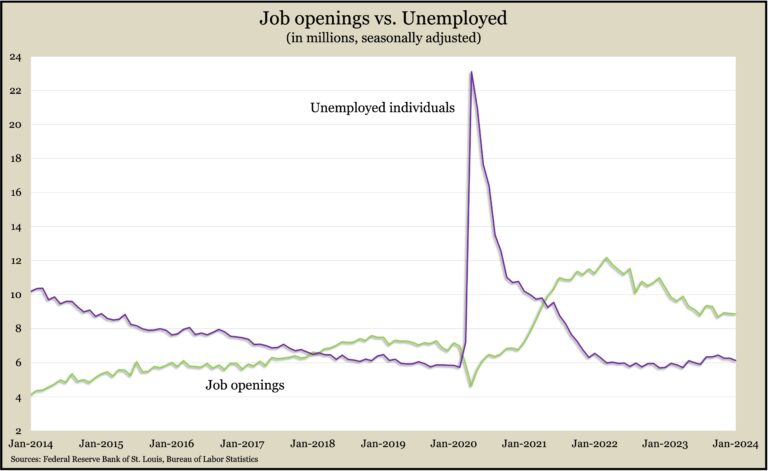Podcast: Play in new window | Download
Advisors on This Week’s Show
(with Max Hoelzl, Joel Dresang, engineered by Jason Scuglik)
Week in Review (March 4-8, 2024)
SIGNIFICANT ECONOMIC INDICATORS & REPORTS
Monday
No major releases
Tuesday
A drop in commercial aircraft demand sent U.S. factory orders lower in January for the third time in four months. The Commerce Department said orders overall declined 3.6% from December and were 1.6% below their level the year before. Excluding volatile orders for transportation equipment, demand fell 0.8% both for the month and compared with January 2023. Core capital goods orders, a proxy for business investments, rose 0.9% for the month and were up 2.5% from the year before.
The service sector of the U.S. economy expanded in February for the 14th month in a row, though at a slightly slower pace. The Institute for Supply Management said faster supplier deliveries and a contraction in hiring slowed businesses in February. The ISM’s survey of supply managers found overall satisfaction in the state of business conditions, although concerns linger over inflation, the labor market and geopolitical conflicts.
Wednesday
U.S. employers posted 8.9 million job openings in January, down marginally from December, the Bureau of Labor Statistics reported. Demand for workers continued to outstrip supply. Openings eclipsed 12 million in March 2022 and have trended lower ever since. They were below 7 million just prior to the COVID-19 pandemic. Measures of hiring and dismissals showed little change, but voluntary quitting – an indication of worker confidence – was below pre-COVID levels for the third month in a row.

Thursday
The Bureau of Labor Statistics said worker productivity rose at an annual pace of 3.2% in the fourth quarter, unchanged from an earlier estimate. The rate resulted from the annual pace of output rising 3.5% in the last four months of the year while hours worked rose at a 0.3% pace. Productivity rose 2.6% over the last four quarters. Average annual productivity rose 1.3% for 2023, compared to an average 2.1% since 1948.
The U.S. trade deficit widened by 5.1% to $67.4 billion in January, the Bureau of Economic Analysis reported. During the month, exports rose by 0.1%, led by autos and consumer goods. Imports rose by 1.1%, led by cars, crude oil and cell phones. Compared to January 2023, the trade gap narrowed by 4.1% as exports declined 0.4% and imports fell 1.2%. Economists consider trade deficits a detraction from overall economic growth.
The Labor Department reported the four-week moving average for initial unemployment claims dropped for the third week in a row. It remained 42% below its average since 1967 and was 2% above its level just before the COVID-19 pandemic. Total claims for the latest week declined marginally from the week before to 2.1 million. That was 10.5% above the mark from the year before.
The Federal Reserve said credit card debt rose at an annual pace of 7.6% in January, up from 2.4% in December, but a slowdown from the third and fourth quarters. The overall consumer debt outstanding, including student loans and car financing, increased at a 4.7% annualized rate. Measured year to year, credit card debt rose less than 2% from January 2023. Such debt has gone up every month but one in nearly three years. Sustained use of credit cards suggests consumers continued spending at higher levels despite Fed interest rate increases aimed at weakening demand to help lower inflation.
Friday
Employers added 275,000 jobs in February, the Bureau of Labor Statistics reported, and the unemployment rate edged up to 3.9%, its highest level in three years. The bureau’s monthly jobs report, combining payroll data and household surveys, showed the pace of hiring rise above the 12-month average, with particular strength in health care, construction and bars and restaurants. The average hourly wage increased 0.1% from January, the smallest boost in two years. Compared to February 2023, wages rose 4.3%.

MARKET CLOSINGS FOR THE WEEK
- Nasdaq – 16085, down 190 points or 1.2%
- Standard & Poor’s 500 – 5124, down 13 points or 0.3%
- Dow Jones Industrial – 38723, down 365 points or 0.9%
- 10-year U.S. Treasury Note – 4.09%, down 0.09 point
